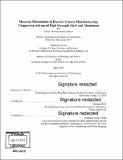| dc.contributor.advisor | Richard Roth. | en_US |
| dc.contributor.author | Burd, Joshua Thomas Jameson. | en_US |
| dc.contributor.other | Massachusetts Institute of Technology. Institute for Data, Systems, and Society. | en_US |
| dc.contributor.other | Technology and Policy Program. | en_US |
| dc.date.accessioned | 2019-09-16T21:18:02Z | |
| dc.date.available | 2019-09-16T21:18:02Z | |
| dc.date.copyright | 2019 | en_US |
| dc.date.issued | 2019 | en_US |
| dc.identifier.uri | https://hdl.handle.net/1721.1/122162 | |
| dc.description | Thesis: S.M. in Technology and Policy, Massachusetts Institute of Technology, School of Engineering, Institute for Data, Systems, and Society, 2019 | en_US |
| dc.description | Cataloged from PDF version of thesis. "The pagination in this thesis reflects how it was delivered to the Institute Archives and Special Collections. TOC and page numbers do not match"--Disclaimer Notice page. | en_US |
| dc.description | Includes bibliographical references (pages 57-59). | en_US |
| dc.description.abstract | In electric vehicle production, the high cost of battery manufacture motivates investment in energy efficient and lightweight vehicle designs. A common lightweighting strategy is to substitute Advanced High Strength Steel (AHSS) or aluminum in place of traditional mild steel. Aluminum is a lighter weight than AHSS, leading to greater reduction of battery and motor costs. However, it is more expensive to manufacture the vehicle body using aluminum compared to AHSS. This thesis is an attempt to answer the question of which material is less expensive from a total vehicle cost point of view, and how that might change as technological learning affects the various vehicle subsystems. A fully designed vehicle with an Advanced High Strength Steel (AHSS) body serves as the basis for an aluminum "comparator" design. | en_US |
| dc.description.abstract | For each design, the cost of manufacturing each part in the body structure and closures, the cost of each assembly joining step, and the cost of painting the assembled body is calculated using process-based cost modeling. Assembled and painted body and closures manufacturing cost for the steel design is $923 and $1798 for aluminum due to higher aluminum material costs and more expensive aluminum part manufacturing, assembly and paint process costs. Lighter body structures require smaller motors, batteries, chassis, and other subsystems in the rest of the vehicle. Secondary weight savings factors derived from statistical mass benchmarking studies are used to calculate changes in curb mass based on the difference in body mass between the steel and aluminum designs. For a 23% weight saving assumption, the aluminum design was 58 kg lighter in the body and closures, and 93 kg lighter in the full curb weight. | en_US |
| dc.description.abstract | The lighter vehicle weight was used to scale costs of batteries, motors, and chassis. In total, the cost of these subsystems was $12,467 in the steel design and $11,754 in the aluminum design. This base case result found that the full vehicle cost of the steel design was $330 less expensive than the aluminum design. Sensitivity and variation of parameters found that the cost advantage of the steel design shrinks with larger assumed weight savings or larger assumed battery sizes. An analysis of how costs are likely to change with time shows that decreasing battery and motor costs will likely outpace decreasing aluminum manufacturing costs such that the steel design may be as much as $500 less than the full cost of the aluminum design by 2030. | en_US |
| dc.description.statementofresponsibility | by Joshua Thomas Jameson Burd. | en_US |
| dc.format.extent | 86 pages | en_US |
| dc.language.iso | eng | en_US |
| dc.publisher | Massachusetts Institute of Technology | en_US |
| dc.rights | MIT theses are protected by copyright. They may be viewed, downloaded, or printed from this source but further reproduction or distribution in any format is prohibited without written permission. | en_US |
| dc.rights.uri | http://dspace.mit.edu/handle/1721.1/7582 | en_US |
| dc.subject | Institute for Data, Systems, and Society. | en_US |
| dc.subject | Technology and Policy Program. | en_US |
| dc.title | Material substitution in electric vehicle manufacturing : comparing advanced high strength steel and aluminum | en_US |
| dc.type | Thesis | en_US |
| dc.description.degree | S.M. in Technology and Policy | en_US |
| dc.contributor.department | Massachusetts Institute of Technology. Institute for Data, Systems, and Society | en_US |
| dc.contributor.department | Massachusetts Institute of Technology. Engineering Systems Division | |
| dc.contributor.department | Technology and Policy Program | en_US |
| dc.identifier.oclc | 1117774188 | en_US |
| dc.description.collection | S.M.inTechnologyandPolicy Massachusetts Institute of Technology, School of Engineering, Institute for Data, Systems, and Society | en_US |
| dspace.imported | 2019-09-16T21:18:00Z | en_US |
| mit.thesis.degree | Master | en_US |
| mit.thesis.department | ESD | en_US |
| mit.thesis.department | IDSS | en_US |
